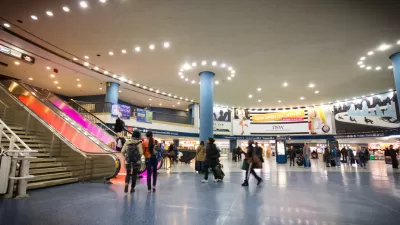Amtrak's Gateway project is not only key to maintaining and increasing commuter and intercity rail capacity between the Empire and Garden States, but also to ensuring that the $1 billion investment in the new Moynihan Station makes sense.
A prior post noted that transit advocates questioned the improvements to New York's Penn Station in the form of the $1 billion Moynihan Station project. It ended with the need to "expand trans-Hudson capacity." However, simply maintaining the current capacity provided by the two aging, damaged tunnels under the Hudson River from New Jersey will not be easy.
"Structural problems in the 104-year-old Hudson River tunnels were exacerbated by 13 million gallons of salt water that flooded them after superstorm Sandy, an event that Amtrak officials confirm will require closing the old tubes for a year for a complete rebuilding," writes Larry Higgs, transportation reporter and columnist for Asbury Park Press.
The existing tunnels, built in 1910 by the Pennsylvania Railroad, sustained salt water damage similar to the kind that forced the PATH rail system to close its Hudson River tunnels between Jersey City and the World Trade Center every weekend until 2015 for repairs and upgrades, said [Drew Galloway, Amtrak chief of Northeast Corridor Planning and Performance.]
Because the tunnels, "used by Amtrak's Northeast Corridor Line and (a)ll of NJ Transit's rail lines to enter and leave New York, except for the Atlantic City Line," notes Higgs, will need to be closed for one year for the rebuilding process, one can not emphasize Amtrak's Gateway Project enough that involves the building of two new rail tunnels under the Hudson River to lead into Penn Station in Manhattan [see Sen. Frank R. Lautenberg press release: Feb., 2011 PDF].
New tunnels would be designed to be resilient against future severe weather, said Galloway.
Higgs is a strong advocate of the Gateway Project, and perhaps surprisingly, does not side with frustrated New Jersey commuters to Manhattan who endured delays last month "after Amtrak problems forced them to close down one of the two aging Hudson River rail tunnels," writes Higgs in his August 26 column.
It's clear from the argument that surfaced on Twitter, captured by Matt Katz of New Jersey Public Radio on WNYC, that rail commuters resent Gov. Chris Christie's (R-N.J) October 2010 cancellation of the Access to the Region's Core (ARC) project that preceded Amtrak Gateway. However, Higgs sides with Christie.
[Christie] told them the ARC tunnel went to the wrong place and would have cost New Jersey taxpayers billions of dollars in potential overruns. I saw the Federal Transit Administration documents that back that up.
In his October, 2010 Planetizen opinion, Ian Sacs, a former Director of Transportation and Parking for the City of Hoboken, N.J., also puts a positive spin on what many saw as a huge blow to Amtrak and New Jersey Transit.
Higgs notes that "nothing has been done on the Jersey side to advance Gateway except for the sharing of engineering and environmental work from the ARC project." He favors a hybrid Gateway project that would get one of the two proposed Gateway tunnels built more quickly that would then allow for closing, one at a time, the existing tunnels for rebuilding in order to maintain current trans-Hudson capacity.
FULL STORY: Amtrak: New tunnels needed after Sandy damage

Study: Maui’s Plan to Convert Vacation Rentals to Long-Term Housing Could Cause Nearly $1 Billion Economic Loss
The plan would reduce visitor accommodation by 25,% resulting in 1,900 jobs lost.

North Texas Transit Leaders Tout Benefits of TOD for Growing Region
At a summit focused on transit-oriented development, policymakers discussed how North Texas’ expanded light rail system can serve as a tool for economic growth.

Why Should We Subsidize Public Transportation?
Many public transit agencies face financial stress due to rising costs, declining fare revenue, and declining subsidies. Transit advocates must provide a strong business case for increasing public transit funding.

How to Make US Trains Faster
Changes to boarding platforms and a switch to electric trains could improve U.S. passenger rail service without the added cost of high-speed rail.

Columbia’s Revitalized ‘Loop’ Is a Hub for Local Entrepreneurs
A focus on small businesses is helping a commercial corridor in Columbia, Missouri thrive.

Invasive Insect Threatens Minnesota’s Ash Forests
The Emerald Ash Borer is a rapidly spreading invasive pest threatening Minnesota’s ash trees, and homeowners are encouraged to plant diverse replacement species, avoid moving ash firewood, and monitor for signs of infestation.
Urban Design for Planners 1: Software Tools
This six-course series explores essential urban design concepts using open source software and equips planners with the tools they need to participate fully in the urban design process.
Planning for Universal Design
Learn the tools for implementing Universal Design in planning regulations.
City of Santa Clarita
Ascent Environmental
Institute for Housing and Urban Development Studies (IHS)
City of Grandview
Harvard GSD Executive Education
Toledo-Lucas County Plan Commissions
Salt Lake City
NYU Wagner Graduate School of Public Service



























